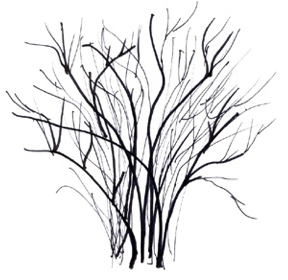Bulletin #2580, Native Trees and Shrubs for Maine Landscapes: American Elder (Sambucus canadensis)
Developed by Marjorie Peronto, Associate Extension Professor, University of Maine Cooperative Extension; and Reeser C. Manley, Assistant Professor of Horticulture, University of Maine.
For information about UMaine Extension programs and resources, visit extension.umaine.edu.
Find more of our publications and books at extension.umaine.edu/publications/.
Go native!
This series of publications is the result of a five-year research project that evaluated the adaptability of a variety of native trees and shrubs to the stresses of urban and residential landscapes in Maine. Non-native invasive plants pose a serious threat to Maine’s biodiversity. Plants such as Japanese barberry, shrubby honeysuckle, and Asiatic bittersweet, originally introduced for their ornamental features, have escaped from our landscapes, colonizing natural areas and displacing native plants and animals. By landscaping with native plants, we can create vegetation corridors that link fragmented wild areas, providing food and shelter for the native wildlife that is an integral part of our ecosystem. Your landscape choices can have an impact on the environment that goes far beyond your property lines.
Description
Form: a multi-stemmed shrub with tightly clustered stems at the base and upright, spreading branches
Size: 6 to 12 feet high and wide
Ornamental characteristics:
- large, flat-topped clusters of white flowers from late June through mid-July
- drooping, flat-topped clusters of deep purple to black berries, borne on red to purple stems from August through September
Landscape Use
American elder is a denizen of wet areas throughout eastern North America, frequenting bogs, marshes, deep woods, and disturbed sites (disturbed by human or natural activity). It can often be found growing in such sites with common winterberry (Ilex verticillata) and alders (Alnus spp.). It is highly tolerant of both flooding and shade, yet flourishes in drier garden sites in full sun.
Because of its leggy growth habit and coarse texture, Sambucus canadensis is often consigned to natural areas of the landscape, yet with thoughtful pruning, you can place it in the garden proper, perhaps framing the garden bench or entrance arbor, or at the back of the mixed border. It certainly belongs in any garden devoted to wildlife, as its fruits are relished by small mammals as well as 48 species of birds.
Culture
Hardiness: USDA zone 3a
Soil requirements: tolerant of a wide variety of soils
Light requirements: full sun to shade
Stress tolerances:
soil compaction — tolerant
pollution — intolerant
deicing salts — intolerant
urban heat islands — tolerant
drought — tolerant
seasonal flooding — tolerant
Insect and disease problems: infrequent
Wildlife Value
Flowers of American elder produce little nectar but are visited by pollen-collecting insects. American elder is host to the cecropia or robin moth, North America’s largest moth. The fruits are eaten by over 40 bird species including catbirds, yellow-breasted chats, rose-breasted grosbeaks, and all thrushes. Fox squirrels, red squirrels, woodchucks, and white-footed mice eat the fruits.
Maintenance
Irrigation: Water shrubs regularly for at least one year after planting. Apply 1 inch of water over the root zone once a week until leaves fall in autumn: in general, a shrub’s root zone extends twice as wide as its canopy. Once plants are established, further watering should not be necessary unless there are extended periods of drought.
Fertilization: Landscape trees and shrubs should not be fertilized unless a soil test indicates a need. Correct soil pH, if necessary, by amending the backfill soil. No nitrogen fertilizer should be added at planting or during the first growing season.
To learn more about native woody plants
Visit the Eastern Maine Native Plant Arboretum at University of Maine Cooperative Extension’s Penobscot County office, 307 Maine Avenue in Bangor. Established in 2004, the arboretum displays 24 different native tree and shrub species that can be used in managed landscapes.
Reviewed by Cathy Neal, Extension professor, University of New Hampshire Cooperative Extension.
Photos by Reeser C. Manley.
Illustration by Margery Read, Extension Master Gardener.
This series of publications and the associated research were made possible in part by the Maine Forest Service’s Project Canopy.
Information in this publication is provided purely for educational purposes. No responsibility is assumed for any problems associated with the use of products or services mentioned. No endorsement of products or companies is intended, nor is criticism of unnamed products or companies implied.
© 2008
Call 800.287.0274 (in Maine), or 207.581.3188, for information on publications and program offerings from University of Maine Cooperative Extension, or visit extension.umaine.edu.
In complying with the letter and spirit of applicable laws and pursuing its own goals of diversity, the University of Maine System does not discriminate on the grounds of race, color, religion, sex, sexual orientation, transgender status, gender, gender identity or expression, ethnicity, national origin, citizenship status, familial status, ancestry, age, disability physical or mental, genetic information, or veterans or military status in employment, education, and all other programs and activities. The University provides reasonable accommodations to qualified individuals with disabilities upon request. The following person has been designated to handle inquiries regarding non-discrimination policies: Director of Institutional Equity and Title IX Services, 5713 Chadbourne Hall, Room 412, University of Maine, Orono, ME 04469-5713, 207.581.1226, TTY 711 (Maine Relay System).





